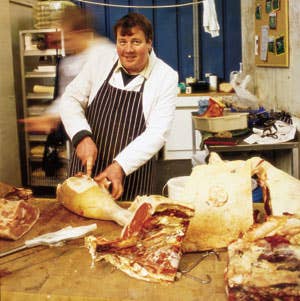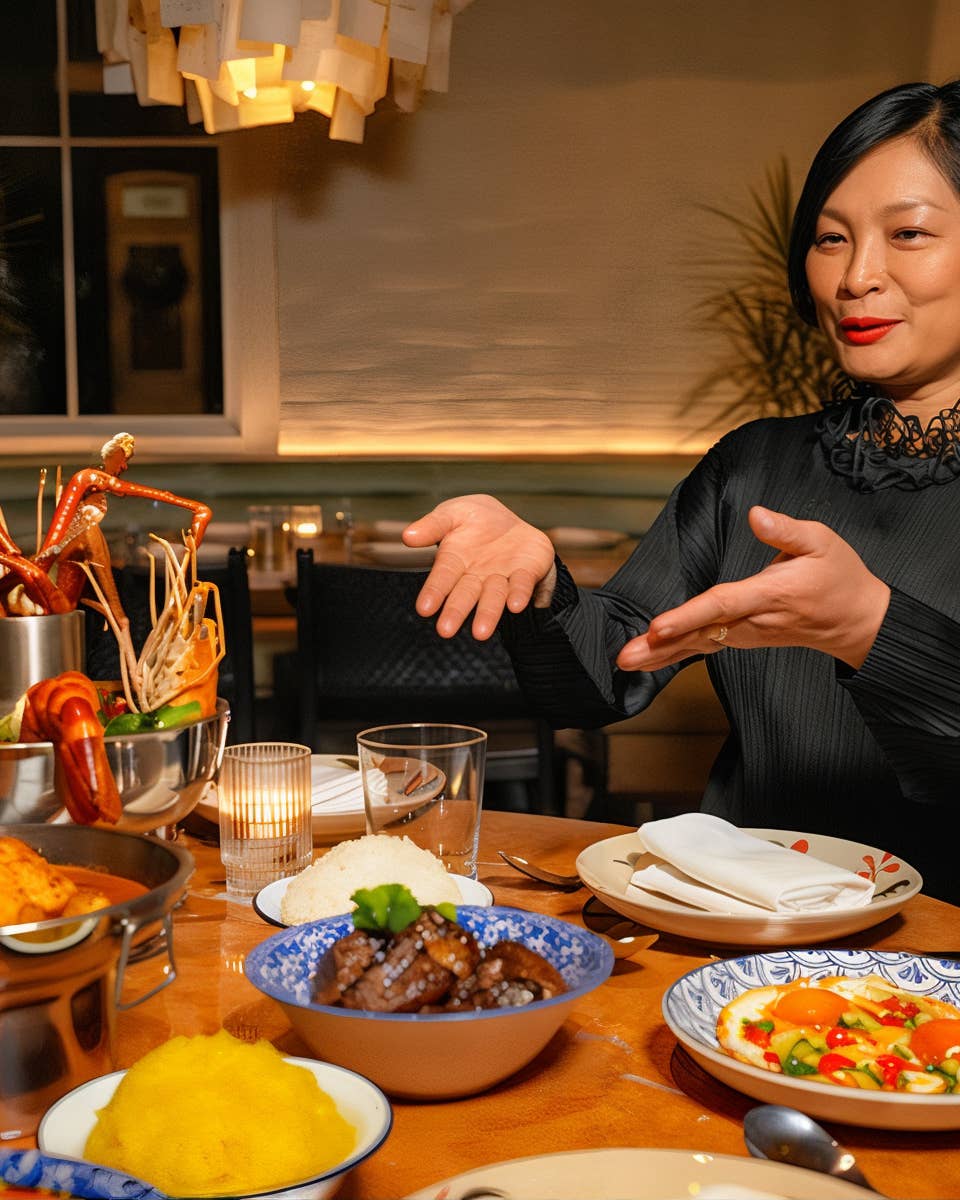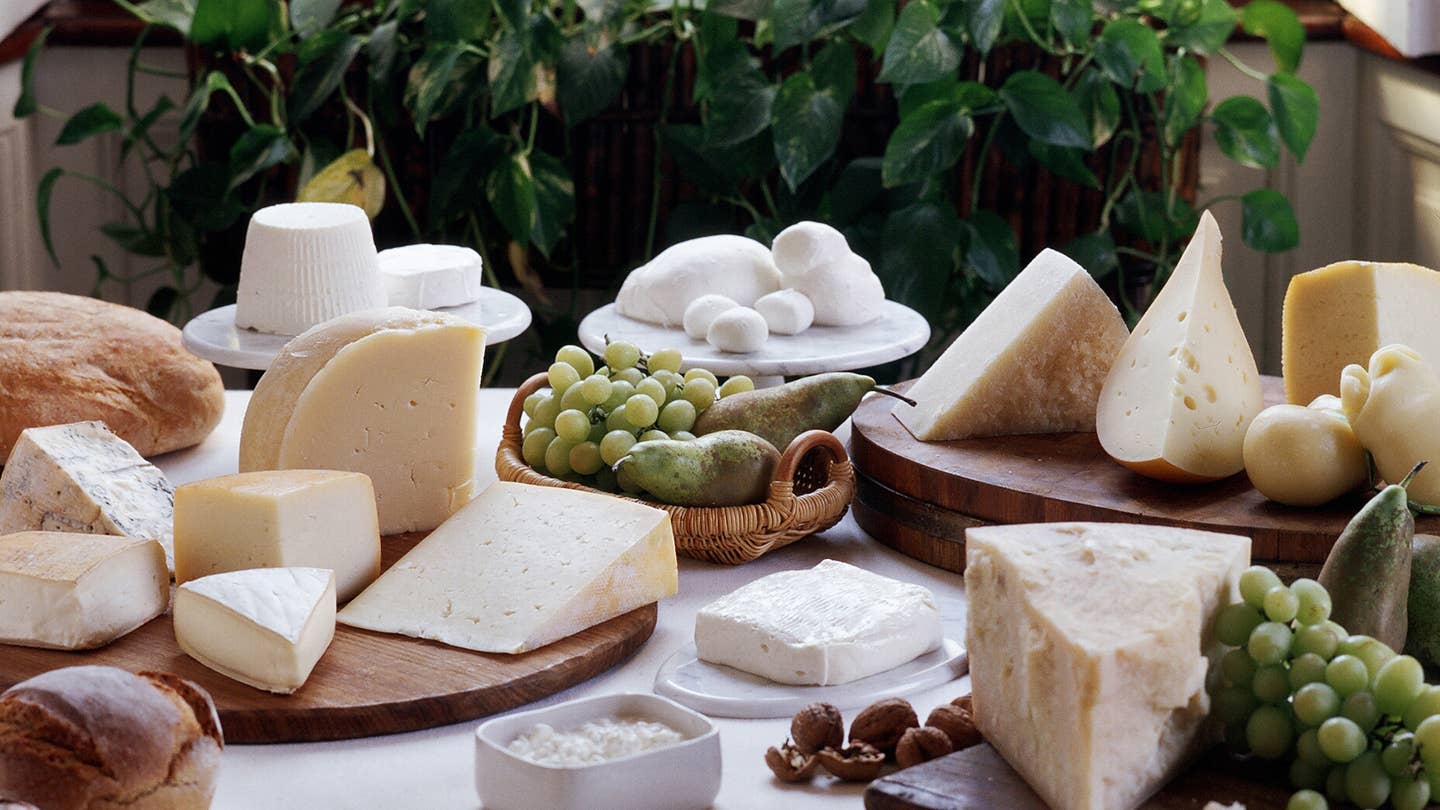
New Life, Old Market
Tony Booth's produce stand at Borough Market, near London Bridge on the south bank of the Thames, is not a cluster of rustic farmer's tables or a pine-floored produce boutique. It's not really a stand at all, in fact; it's a patch of concrete partially enclosed by chain-link fence and filled with stacks of crates and flats and boxes, some on pallets, some directly on the floor. And no farmer, even in Provence or California, could mount, all at the same time, in earlyMarch, the array of fruit and vegetables these crates and flats and boxes contain. Wild mushrooms from various corners of Europe and Asia—chanterelles, cepes, morels, trompettes de mort; shaggy heads of cauliflower, vivid orange savoy carrots, pale zucchini flowers, lacy asparagus shoots, lightly speckled radicchio di castelfranco, dusty red fraises des bois, plump Peruvian figs, paper-hulled Zimbabwean ground cherries; bouquets of baby chard, rocket (as the English call arugula), spinach, chicory…
Booth sells this variety in these surroundings because he is a produce dealer to the trade, as his father was, importing goods from all over the world to supply professional kitchens in London and beyond. But every weekend, he and some of his colleagues open their businesses to the general public, joining scores of smaller retail merchants (hawkers of farmhouse cheeses and artisanal breads, sellers of coffee and chocolate, specialty grocers, and the like) to turn what has for 250 years been primarily a wholesale enterprise into a public marketplace—with wholesale prices—that is almost certainly the liveliest, most colorful, most sensually satisfying place to buy food in England.
Taking time off from his cheese shop and warehouse across the street, Randolph Hodgson is shopping at Tony Booth's, buying food for the Sunday lunch he and his wife, Anita Le Roy, plan to cook the next day at home. It is at least partly thanks to Hodgson that there is a retail market here at all. As proprietor of Neal's Yard Dairy, the Covent Garden cheese shop, Hodgson has sold—and promoted—British farmhouse cheeses since the 1980s. In 1997, with his business expanding, Hodgson opened a warehouse across the street from Borough Market. One of the market wholesalers, Spanish food importer Monika Lavery, had started opening her own Brindisa warehouse to the public four times a year, sending out announcements to friends and colleagues and selling goods at bulk prices right off the pallets. Hodgson thought this was a wonderful idea and got together with Lavery, coordinating their mailing lists and opening his warehouse simultaneously.
In November of 1998, at Hodgson's invitation, food and consumer affairs journalist Henrietta Green staged what she called a Food Lovers' Fair at Borough Market, inviting a host of British specialty farmers and producers to sell their wares to a public hungry for authentic foodstuffs. (She now stages the events every second Friday of the month at Covent Garden.) "That got us going," says Hodgson. Before long, the market was opening one Saturday a month, then every Saturday, then every Friday and Saturday; today some merchants sell on Thursdays, too, and about 70 producers, both wholesalers and retailers, now participate.
As he talks, Hodgson is picking out produce at Tony Booth's—fingerling potatoes, broad beans (the English term for favas), morels, various baby greens, a few huge stalks of rhubarb. "Do you know these?" he asks, pointing to a heap of small, thin-skinned, green peppers. They're pimientos de Padron, the legendary Galician frying peppers, mild except for the occasional one that will take your head off. He buys a bagful; then, leaving his purchases with Booth to be picked up later, he takes me on a tour of the market.
Amid bright signage, vivid produce (thickets of carrots, pyramids of lemons, cascades of cabbages), and the whirl of motion, crowds cluster around this stand or that, picking out fruit, asking questions about meat, chattering, trading food tips and impromptu recipes, buying. We pass a stand devoted to Melton Mowbray pork pies, from the Leicestershire town of the same name—"the best meat pies in England," Hodgson assures me. Huge chunks of meat and game are on display at Sillfield Farm Products, where a sign boasts, "Wild boar is back again, first since F&M [foot and mouth disease] crisis, fresh from Cumbria" (the crisis is now over). We pass a produce stand called Total Organics, whose motto is "Vegetables That Don't Bite Back", and stop instead at a stand run by a handful of men who claim to be called "Peter and the boys with no name", where Hodgson
buys flat-leaf parsley and red oakleaf lettuce.
We stop to pay our respects to Nancy Mahon, a former barrister, who presides proudly over sealed plastic bowls of old-fashioned treacle pudding, sticky toffee pudding, and other tooth-gluing treats at her Pudding Lane stand. It's halfway between breakfast time and lunchtime, so we pass up all the savory-looking (and -smelling) market food offered on every side—venison burgers, chicken and rocket roll-ups, black bean chili, seafood spring rolls, wood-fire chorizo sandwiches, banana fritters—and head for the Monmouth Coffee stand, which is run by Hodgson's wife, Anita, for white mugs of rich, hot Brazilian brew. Anita, who has a full-scale shop across the street next to her husband's cheese emporium and another near the original Neal's Yard Dairy—she is to coffee in London what her husband is to cheese—brews coffee a cup at a time directly into white mugs, through paper filters in white ceramic cones set in a row into a wooden rack—an artisanal assembly line. "People think making good coffee is hard," says Anita, "but it really isn't."
We continue on, passing Scandelicious, a Scandinavian delicatessen doing a brisk trade this morning in gravlax and herring, and New Forest Cider, where marketgoers are lined up to buy bottles of potent "scrumpy" (hard cider) fermented in Hampshire from the juice of heirloom apple varieties. "We get a certain number of celebrity shoppers here now," says Hodgson as we stroll. "The remaining 'Fat Lady', Clarissa Dickson Wright; Jonathan Meades [celebrated restaurant critic of the Times]…" At that moment, as if on cue, we pass Jamie Oliver, TV's "Naked Chef", buying ginger-and-honey truffles from Fatou Mendy at her stand, Dark Sugars. "He shops here every week," Hodgson remarks, "but in the TV commercials he says he shops at Sainsbury's [the big supermarket chain]."
At the Ginger Pig, Hodgson buys half a pound of smoky bacon from proprietor Tim Wilson. Also on display are bacon ribs, bacon joints, and bacon hocks. "And his beef is incredible," adds Hodgson. He briefly considers that as a main course for Sunday lunch, then leads me over to Farmer Sharp's Herdwick Lamb (see box, page 86) instead, where from fifth-generation meat man Andrew Sharp he acquires a five-pound bone-in shoulder of mature wether—sheep in the pre-mutton stage. "This will be something you won't find in America," Hodgson promises.
Borough Market takes its name from its neighborhood, the borough of Southwark—or simply "the Borough". One of the oldest parts of London, Southwark is in turn named for the suthringagewoerc (military encampment) built by the Saxons here in a.d. 944 at the southern terminus of the wooden bridge they constructed across the Thames. The earliest mention of Borough Market as a recognized institution came in 1276. The market has moved a bit several times since then but has occupied its present four-and-a-half-acre site since 1754 and is said to be the city's oldest fruit and vegetable wholesale market still trading at its original location.
The market is administered by a board of 21 trustees, all local residents; and in the early 1990s, the group grew concerned about the future of the market. "Like all the wholesale markets in London," says George Nicholson, chairman of the trustees, "Borough Market started shrinking in size as eating patterns and food-buying habits changed." Seeking to preserve the vitality of the market, the trustees sponsored a competition asking for proposals for the addition of a retail space. "My issue with this kind of development," says Randolph Hodgson, "was that it was from the top down, if you will; if you build and then bring in tenants, you risk ending up with something fairly anodyne and sterile. My point was, why don't we get the market going and then build around it?" With Hodgson's help, that's exactly what happened.
Borough Market has an appealingly anarchic quality to it today. A little web of streets beneath a skylit cast-iron canopy, with an interior defined by green and primer-coated girders, chain link, plywood, and canvas, it's jumbled up, a little confusing, cosmetically smudged—all of which qualities make it seem genuine. In remaking the space, Ken Greig of Greig + Stephenson, the London architecture firm that eventually won the trustees' commission, promises not to pretty things up too much. "The basic idea," he says, "is to keep the market permeable. It will be always open on all sides. What we're doing is all about the people and the merchandise—not so much about making it attractive." His work is scheduled to be finished in 2004.
It's Sunday, and Borough Market is closed, but at their warm, attractively cluttered house about five miles away, in the area of London known as Little Venice, Hodgson and Le Roy are cooking an informal market-based lunch for themselves, two of their three children—Kit, 11, and Anna, 15 (their 18-year-old son, Raef, is away at school)—and their friend Anne Hastings, who works in the Neal's Yard shop and office.
Moving comfortably around their open kitchen, they approach their food sensibly, as most good cooks did in the days before television chefs and recipe encyclopedias: having brought home a variety of fresh, good, seasonal, compatible raw materials—morels, broad beans, fingerling potatoes, salad greens, Spanish frying peppers, rhubarb—they set everything out on the kitchen shelf and figure out what to do with it (the lamb is already roasting slowly, with small white onions and sprigs of thyme and rosemary).
"What do you think?" asks Randolph. "The morels with the potatoes or with the broad beans?" "Broad beans," answers Anita. "We can toss some bacon with the fingerlings." And the rhubarb? "We'll just bake it with lots of sugar," Anita suggests. "Maybe some orange zest, too." They set to work, with a casual, improvisational attitude. Kit and Anne shell broad beans on the bare, handsome, well-worn dining-room table. Randolph cuts up some bacon and starts it gently sizzling in a pan. Anita washes and dries an immense pile of tiny salad leaves. Randolph busies himself in one corner of the kitchen for a few minutes, then turns around with a platter of little scraps of toast topped with chutney and melted lancashire cheese—a snack while lunch is cooking. Then he opens a bottle of bandol rouge and turns to the pimientos de Padron, which he is going to fry quickly in olive oil.
Lunch is served. The chairs and plates and glasses don't quite match, but everything is in harmony. Bright gray light streams in through the very high bay windows. Wine flows. Talk flows. The lamb is dense, like venison, and full of flavor, meaty and sweet. The fried peppers are a spicy lot. The potatoes and bacon taste earthy and slightly smoky. The morels and broad beans taste like spring. The table honors the market.
Keep Reading
Continue to Next Story










